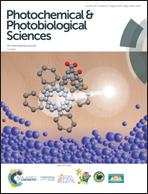Novel ruthenium(ii) and iridium(iii) BODIPY dyes: insights into their application in photodynamic therapy in vitro†
Abstract
Organic–metal complexes are promising molecules for use in photodynamic therapy (PDT). The aim of this study was to investigate in vitro effects of novel Ru(II) and Ir(III) BODIPY complexes for PDT. These hybrid organic–metal molecules (Ru-BD and Ir-BD) have been synthesized via reactions of a BODIPY precursor (BD) with a phenanthroline unit bearing Ru(II) (3) and novel Ir(III) (4) compounds. The crystal structures of the new distyryl BODIPY (BD) and Ru(II) complex (3) are also reported. The photophysical and singlet oxygen generation properties of Ru-BD and Ir-BD were investigated in comparison with unsubstituted BODIPY (BD). Moreover, Ru-BD and Ir-BD have been biologically evaluated in vitro in chronic myeloid leukemia and cervical cancer cell lines in terms of photodynamic therapy efficacy in the presence of BD control. These complexes were not toxic in the dark but red light was needed to induce cell death. These data support the fact that Ru-BD could be accepted as a valuable photosensitizer-drug for further PDT treatment.



 Please wait while we load your content...
Please wait while we load your content...